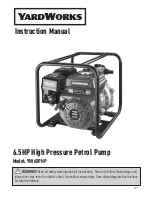
EN
37
• If dust extraction and dust collection
equipment is available, this should be
connected and used correctly. The use of
such devices can reduce the risk of
dust-related problems.
• Pay attention to what you are doing at
all times, and use your common sense.
A moment of inattention can result in
serious personal injury.
USE AND CARE
• Do not force the tool. Always use the
correct tool for the job. The tool does the
job better and safer when used at the rate
for which it was designed.
• Do not use the tool if it cannot be
switched on and off with the power
switch. Power tools that cannot be
controlled with the power switch are
dangerous and must be repaired.
• Pull out the plug and/or remove the
battery before making any adjustments,
changing accessories or putting the power
tool away. These safety precautions
reduce the risk of accidently starting the
power tool.
• Store power tools out of the reach of
children when not in use. Never allow
children, or anyone who is unfamiliar with
the power tool and these instructions, to
use the tool. Power tools are dangerous if
used by inexperienced persons.
• Keep the power tool properly maintained.
Check that moving parts are properly
adjusted and do not jam, and that no
parts are incorrectly fitted or damaged.
Check for other factors that could affect
functionality. If the power tool is
damaged, it must be repaired before
being used again. Many accidents are
caused by poorly maintained power tools.
• Keep cutting tools sharp and clean.
Properly maintained cutting tools with
sharp cutting edges are less likely to jam
and are easier to control.
• Use the power tool, accessories and bits
etc., in accordance with these instructions,
taking into account the actual working
conditions and the work that is to be
done. It can be dangerous to use power
tools for purposes other than those they
are intended to be used for.
• When not in use, store the tool in a dry
place out of the reach of children.
• Keep handles and grips clean, dry and free
from oil and grease. Greasy handles and
grips make it difficult to hold the tool.
USING AND MAINTAINING
BATTERY-POWERED TOOLS
• The battery must only be charged with the
charger recommended by the
manufacturer. A charger intended for one
type of battery can result in a fire risk if
used with another type of battery.
• Only use power tools with the specified
batteries. The use of other batteries can
cause accidents or a fire.
• When the battery is not in use keep it away
from metal objects such as paperclips,
coins, keys, nails, screws and other small
metal objects that can short circuit the
terminals. Short circuiting the battery
terminals can cause burns or a fire.
• Failure to handle the battery carefully can
cause fluid to leak from the battery. Avoid
contact with battery fluid. Fluid leaking
from the battery can cause irritation or
burns. On contact with battery fluid, rinse
immediately with plenty of fresh water.
Seek medical attention on contact with
battery fluid.
• Do not use damaged or modified
batteries – risk of explosion, fire, personal
injury and/or material damage.
• Do not expose the battery to naked flames
or heat. Batteries can explode at
temperatures over 130°C.
Содержание 007636
Страница 4: ...1...
Страница 5: ...2 3 5 4 6...
Страница 6: ...7 8 9 11 10 12...
Страница 7: ...13 15 14...








































